Galapagos - Tourism

Lovesail
Mon 20 Apr 2015 02:54
|
09:56.2S 139:06.7W
Sent from Vaitahu on the island of Tahuota in the Marquesas.
Yes, I know this is a bit late and it’s sent from the wrong place,
but the draft of this blog has been sitting waiting until we had good wifi
in order to include lots of photos. However after two weeks in the
Marquesas I know that “good” wifi does not exist here so I’ve had to cut the
photos to the minimum and send by satphone connection. Sorry. More blog
about the past two weeks to follow.
We arrived in Puerto Baquerizo Moreno on the island of San Cristobal
on 24 Feb. First things first, we had to complete the formalities.
Besides the usual customs and immigration, there is a strict quarantine regime
focused to keeping out introduced species. Firstly, and most important,
the bottom of the boat has to be clean and free from growth, barnacles, crabs,
etc. We had had lots of warning about this, had cleaned up in Islas
Perlas and again before coming into port. Divers came to inspect our
bottom and we were passed as clean. Phew! The price of failure is to go 40
miles offshore, clean up and then return. Not a good prospect. We
also had to have arrangements for sorting our rubbish, no pests on board, no bad
fruit or vegetables and the all important fumigation certificate that we had
done in Panama. Quite a rigmarole. Here is the team that
arrived to check us over:
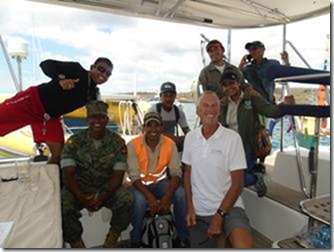 Once that was complete, we were allowed ashore but not in our own
dinghy. They operate a system of water taxis in the anchorage so you call
up or just wave until you get picked up and dropped at the dock for a
dollar. Quite a good system really. Then you have step over the sea
lions and iguanas on the jetty and finally arrive on terra firma. A bit of
a hoot to begin with but we did start to tire of the sea lions all over
Lovesail. Messy creatures and not always cooperative about getting out the
way. We had to build barricades of fenders and lines to stop them climbing
into the cockpit, not always successfully. It’s a bit of a shock to the
system to be woken in the night by a sea lion flapping about in the cockpit and
getting into a state.
Sea lions on Main Street:
 Sea lions on Lovesail:
 Sorry, this is supposed to be about our stay ...... B. Moreno is
rather an attractive little place with a nice promenade along the sea front,
restaurants and bars and tour operators all conveniently nearby. It all
goes at a nice gentle pace. We were quick off the mark to arrange some
trips for ourselves, starting the next day. These usually involve getting
into a local boat, together with a Park Ranger, in the morning and speeding off
to the chosen location. These boats carry 10-20 passengers and provide
snorkelling gear, if needed, plus snacks and lunch. It all works very
smoothly.
Day 1: E&M took an easy tour to a small island off the north
coast. On the way we saw boobies, frigate birds, etc. and then, on the
island,iguanas nesting and a small colony of sea lions. Next up was a
guided snorkel swim and the young sea lions came out to swim with us too. Quite
a start. Later we went to a sandy bay on the main island for more
swimming. More sea lions, and four eagle rays in the shallow water
apparently engaged in mating. We were very satisfied when we got back to
LS. Meanwhile Lucy and Craig had been on a diving trip and had a wonderful time
swimming with all manner of fishes including hammer head sharks.
Blue footed booby, frigate birds, iguanas:
   Day 2: A bit of a rest day. We explore the town. Had a
delicious lobster lunch ashore and arranged more trips/travel with the local
agent.
A finch! Sharing our lobster:
 Day 3: Another trip by boat. This time with Bungles and Lucy and further up
the coast. Also on the boat were three other rally folk. We landed on a
beach and set off on foot through the arid region called Galapaguera to look for
tortoises in the wild. We were not disappointed. First there were
some obvious tracks in the dusty soil that we followed until we found them,
sitting in the shade of a tree. Wow! They are big, and they are in their
natural habitat. Wonderful. On our walk our guide was telling us many
facts about the plants, the birds, tortoises and so on. It’s worth noting
that there has been a lengthy programme to remove wild goats, dogs and cats from
some of the most sensitive areas and this has been hugely successful.
Goats in particular destroy the vegetation and are very harmful to the delicate
environmental balance. Cats and dogs too are a major threat to the birds
and animals that nest on the ground, especially when you consider that there
were no such mammalian predators before the human population arrived.
After the tortoises, it was back to the boat and on to a spectacular bay
surrounded by high cliffs which we then set off to climb on our way to a
location where the three species of booby can all be found nesting. Red
footed, blue footed and nazca boobies were all there for us with their young,
although it was not the right season to witness the famous courtship ritual of
the blue footed boobies.
Hunting for tortoises:
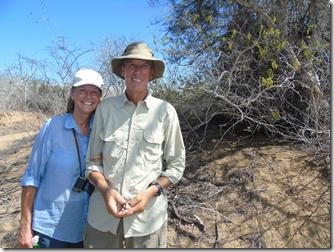 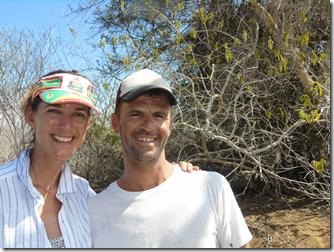 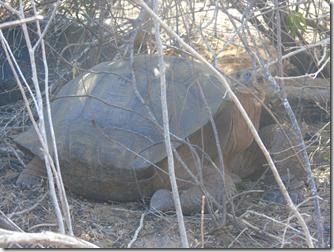 Baby booby:
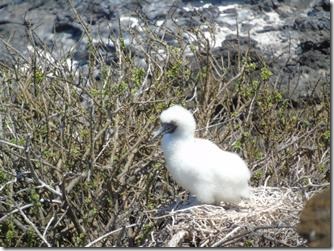 On the boat:
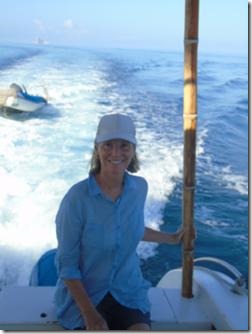 We returned from these trips with a deepened knowledge and appreciation of
the remarkable ecology of these islands but felt that more of the same might be
a bit much for now. What we wanted was to get away from the town and do
something on our own, away from the rest of the rally crowd. We had been
told that we were not permitted to cruise the waters in our own yacht but we had
a few days to spare before the rally was due to move from B. Moreno to the
principal island of Santa Cruz, but what about the other islands? We
decided then to take ourselves to the island of Isabela. Since there were
no airplane seats available, we had to take a water bus on the two hour ride to
Santa Cruz, stopover for a few hours and then take another two hour ride to
Isabela. Off we went. Fortunately it was flat calm as we sped our
way at 25 knots. Incredibly, there were turtles all over the sea and the
skipper had to steer between them. The stopover in Puerto Ayora, Santa
Cruz, allowed us to recce for our visit the following week. We also bumped into
the shore team of the World Arc rally who have been taking a similar itinerary
to ourselves but are a week or two ahead of us. We had met these chaps
already in San Blas so we had a nice chat and they gave us some helpful
tips. While Pto. Ayora is a bigger version of B. Moreno, Villamil on
Isabela is something very different. Isabela is the largest of the islands
but has the smallest population – only 2,000 souls and only 40 cars. The island
has only been open to tourism for 10 years so there is very little development:
some hotels and hostels in the small town, and that’s it. We had arranged
a hotel room on the beach (which is spectacular) and so we rode down the sandy
road in a pickup from the dock to the hotel which suited us perfectly. After
settling in, we took a walk down the beach and wandered into a most attractive
beach bar – Beto’s Bar – which was throbbing to music and serving dynamite
caiparinos. There we fell into conversation with a good looking american
guy who was an artist specialising in creating objects from rubbish, you know,
the miscellanea of plastic bits and bobs, old flip flops, glass,fishing gear and
stuff that you find on the beach and around the place. But the
extraordinary fact was that he was from East Hampton, NY, where he has a
business doing pool maintenance! Soon we were good buddies and he says
“Hey, you must come up to my room/terrace to watch the sun set. It’s the
best room in Villamil.” So we go up the back steps of the bar a couple of
flights and emerge onto a great terrace overlooking the beach with one small
room opening onto it. Fabulous. He produces a bottle of rum and we
toast the sunset. Here’s to you, Billy!
Beto’s Bar with Billy’s terrace on the top:
  In the morning, we take a short trip to an area called Los Tintoreros which
is a lava field just off the coast and an absolute favourite spot for marine
iguanas which were nesting all over the place.
Next morning, we set off an another boat trip to what is called Los
Tuneles. It’s an extraordinary area of flooded lava field inside the
fringe reef. There was a big swell running and the passage through the
pass in the reef was an experience I’d rather not repeat. Once inside, it
was flat calm among a labyrinth of lava and sea. This is where the
penguins like to hang out and we had some memorable swimming and
snorkelling among penguins, turtles, sharks and an amazing foot long sea horse
which, we were told, was new to science and was only discovered 4 years
ago. A totally mysterious place.
  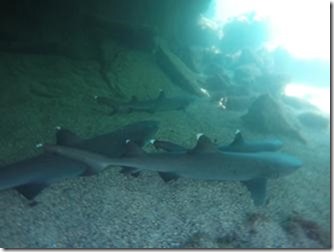  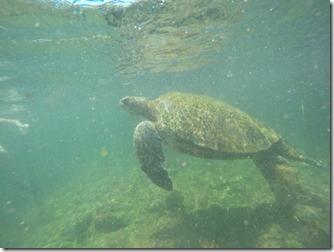 On the following day we climb the volcano, Cerro Negro, 1,000 metres.
Actually there are five volcanoes on the island and the island as we know it
today, was once five separate islands. But as the volcanoes grew in size,
they merged into one big island. But, Galapagos style, there are still
separate species of tortoise on each volcano, reflecting the fact that they were
once isolated from each other. After the climb we went for lunch at a
finca in the lower farming area and had a delicious meal and a quiet rest in the
shade of a huge mango tree.
 Then we had to get back to P. Moreno where we had left Lucy & Craig on
the boat, since the schedule called for us to move to Sta. Cruz. This time
we were lucky to get a plane ride, arrived back on the boat and set off
immediately. By 5 pm we were anchored again in the busy port of Pto.
Ayora. However we hadn’t had enough of Isabela so the next day we left LS
at anchor and took off again by water bus back to Isabela, this time with Lucy
& Craig. We installed ourselves in Billy’s room - he had moved on by
now- at Beto’s Bar, Lucy & Craig were in the annexe across the road
and settled down to enjoy our last few days in the islands.
Views from our room:
 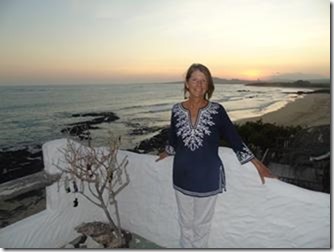 Now it was time to chill out and take advantage of the first half-decent
wifi connection we had had for a long time to sort our stuff. This really
was a heavenly time in a place that feels as if it hasn’t yet been discovered by
the tourists. Just enough infrastructure to take care of the essentials
but that’s it. Lot’s of crazy animals and plants, and masses of land
without humans, plus a five star beach. Bungles managed to find the surf
spot and was out there on the waves with the locals, including surfing iguanas
and sea lions.
Main Street:
 Flamingo, whimbrel, and stilts:
   Meanwhile we took another walk along the shore between the sea and the
mangrove swamps, where the flamingos live, until we finally arrive at the site
of what had been a penal colony during the 50s. Regrettably this was a
scene of some terrible abuses and there remains an extraordinary structure
called the Muro de Lacrimas – the Wall of Tears. It’s a massive wall
comprised of large lava rocks. It rises about 50 feet and, at its base, is
maybe 10 metres thick and 200 metres in length. It serves no purpose but
must have been constructed at the whim of some sadistic camp commander by the
unfortunate prisoners. One cannot imagine the horror that that must have
entailed. In spite of this dark memorial, our walk was a
delight We were in the dry forest amongst the lava and cacti for
hours and by this time we had become quite good at identifying tortoise tracks
and tortoise poo, so we followed these clues and were lucky enough to find SIX
tortoises in the wild, three of which were GIANTS and one of these giants was
laying her eggs! Wow, how cool is that?
Three days later we returned to Pto. Ayora and the next couple of days were
spent doing the usual: final provisioning, fuel and gas, and customs/immigration
formalities. We also paid a visit to the Charles Darwin Research Centre
where Lucy had completed an internship many years ago.
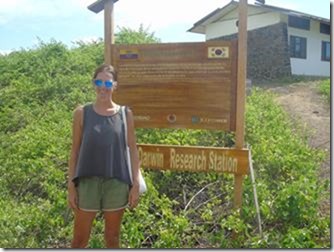 Then our two weeks in the Galapagos was over and it was time to set sail
for the Marquesas.
M
|